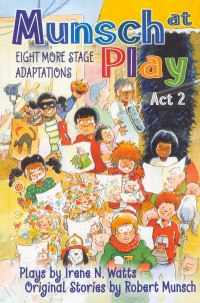| ________________
CM . . .
. Volume XVIII Number 17. . . .January 6, 2012 
 |
Munsch at Play Act 2: Eight More Stage Adaptions.
Irene Watts. Original Stories by Robert Munsch. Illustrated by Michael Martchenko.
Toronto, ON: Annick Press, 2011.
108 pp., hardcover, $24.95.
ISBN 978-1-55451-358-1.
Subject Heading:
Munsch, Robert N., 1945- - Adaptations.
Grades 1-4 / Ages 6-9.
Review by Keith McPherson.
*** /4
|
| |
|

excerpt:
PARENTS: We have to leave.
MOTHER: There is no food.
FATHER: And we are getting shot at.
SAOUSSAN: My father left and was gone for along time. But one day…
(SISTER hurries home, waving an envelope, and gives it to MOTHER).
SISTER: Mother, a letter came.
(MOTHER opens the envelope and takes out three tickets.)
MOTHER: Father has sent us tickets to go to Canada.
SAOUSSAN: I did not know anything about Canada, but the next day I was on a plane going there. (From "From Far Away," p. 88)
Munsch at Play Act 2 is Irene Watt's second volume of plays based on eight more Robert Munsch books: The Fire Station, I Have to Go, Something Good, David's Father, Jonathan Cleaned Up-Then He Heard a Sound, Show and Tell, From Far Away, and Pigs. Similar to the first volume, Watts has made minimal changes to Munsch's stories, although like most plays, it is important to note that these stories are punctuated with staging directions that better serve actors than readers.
The format of these plays is also identical to the first volume, with each play being preceded by a list of cast members, direction for staging, ideas for set design and creative suggestions for props and costumes. Each play suggests casts of between 6 to 24 actors, although teachers can accommodate larger classes by increasing numbers of grouped actors (e.g., increasing number of pigs from a group of 10 to 15 in the story Pigs). Each play runs between 10 to 15 minutes.
Each play is lightly peppered with three or four key Michael Martchenko illustrations taken from the original texts. Images have been chosen to set the tone of the story and often give actors visual insights into the demeanour of key characters and the depth of the humour and/or 'crisis' in each story.
Irene Watts' ability to adapt Munsch's story to stage is best highlighted in her adaptation of From Far Away. Unlike the rest of Munsch's stories, From Far Away is a story of hardship and a family's struggle to culturally acclimatize to a new home and new school in a new country far away from family and friends. Irene very tactfully includes actions, props, stage movement, and pauses that accentuate the pain, the fear, the joy and the utter courage it takes for a war-shocked immigrant child and her family to start a new life in Canada. Few parents watching their children perform this play will not have a tear roll down their cheeks when Saousan cries in her teacher's arms because she cannot find the English to tell her teacher and her new friends that she is sorry for being scared in her new school.
In the preface of this volume, teachers are encouraged to read the Munsch plays to the class in their entirety, especially before student practice reading out their parts. I would further recommend reading the original text before the play so children can hear and experience the whole story before they try to dramatize a variety of play narratives into a concerted story. Having said this, once the students hear themselves (or see themselves in video) a few times, the story will flow and be a testament to how well Watts has adapted these print-based stories for multiple voices and the stage context.
Similar to Leanne Ryrie's review of the first volume, Munsch at Play, I found that some of the prop designs and staging directions were too complex and intimidating for young actors (five- to seven-year-olds) to easily accomplish without assistance from teachers, parents, or older 'buddies'. For example, in Johnathan Cleaned Up, it is suggested that a refrigerator prop be created so that it has "a double sided cutout: the front shows the doors closed, the back shows empty shelves."
Additionally some of the stage direction may be too daunting for young actors, and thus I agree with Ryrie's suggestion that these directions may need to be altered to suit young children's abilities (e.g., the narrators in Pigs are asked to "place the benches or cubes in the shape of a bus and raise their sticks to become the doors." Teachers could either omit these actions altogether or more simple actions and direction could be created). Having said this, it is important to note that these more advanced prop designs and staging directions could easily be created and/or followed by eight- and nine-year olds.
Many primary and early intermediate teachers will thank Irene Watts for adapting and narrating eight more of Munsch's most beloved stories for the stage. Children will thrill at the chance to be a rising star in their favourite stories, and audiences will delight in having Munsch's works come alive in front of their eyes and through the actions of their children. A must-have for any teacher wishing to have 6- to 9-year-olds experience story through drama.
Highly Recommended.
Keith McPherson has been an elementary teacher and teacher-librarian in BC since 1984, and he is currently a lecturer for the Department of Language and Literacy Education at the University of British Columbia in Vancouver, BC.

To comment
on this title or this review, send mail to cm@umanitoba.ca.
Copyright © the Manitoba Library Association. Reproduction for personal
use is permitted only if this copyright notice is maintained. Any
other reproduction is prohibited without permission.
NEXT REVIEW |
TABLE OF CONTENTS FOR THIS ISSUE
- January 6, 2012.
AUTHORS |
TITLES |
MEDIA REVIEWS |
PROFILES |
BACK ISSUES |
SEARCH |
CMARCHIVE |
HOME |
